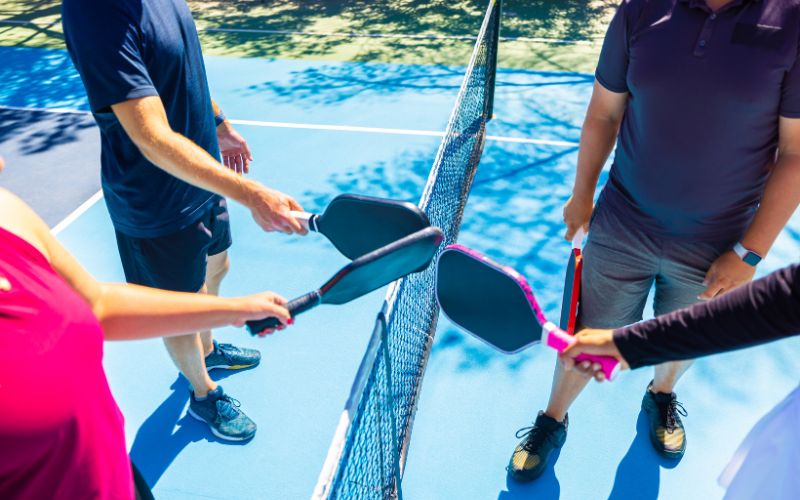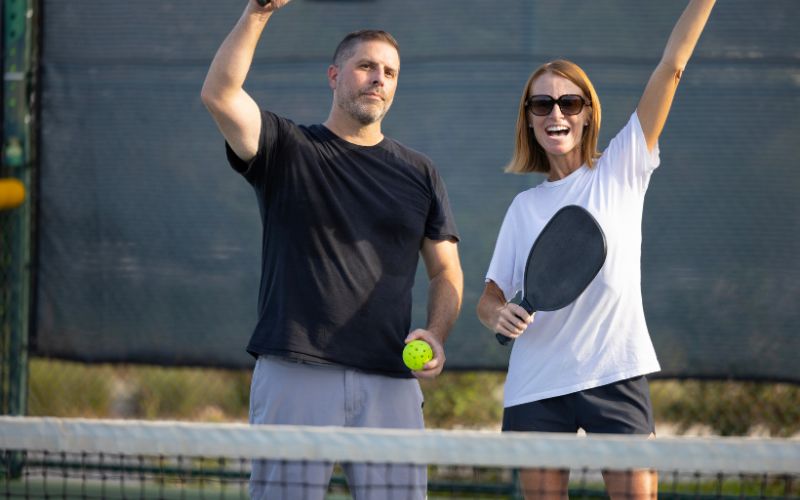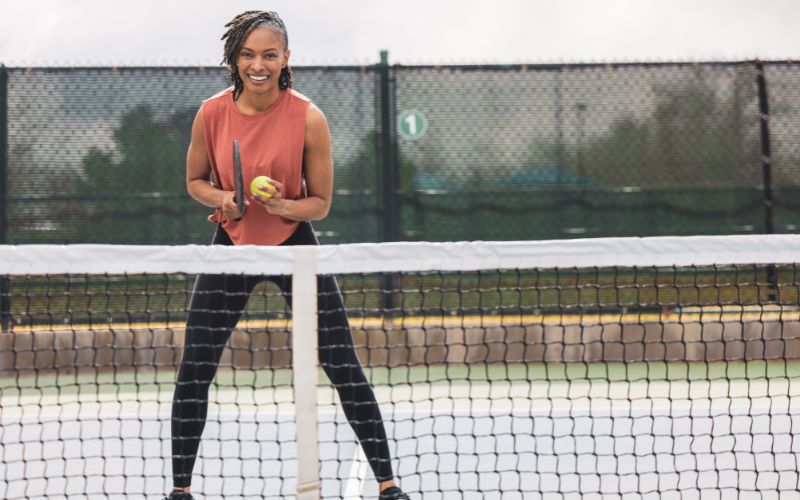Pickleball has emerged as a beloved recreational and competitive sport, drawing enthusiasts of all ages and skill levels. However, like any physical activity, it carries inherent risks of pickleball injuries and overuse strains. To fully enjoy the game and mitigate these risks, pickleball players must prioritize safety measures and adhere to proper guidelines. This article offers a comprehensive guide on how to play pickleball safely, emphasizing injury prevention strategies, pickleball safety tips, and essential considerations for maintaining physical well-being on the court.
Understanding Pickleball Injuries and Risks
Before delving into safety protocols, it’s crucial to recognize the common pickleball injuries and potential risks associated with the sport. From tennis elbow to more severe conditions like traumatic brain injury, pickleball players can encounter various physical strains and acute overuse injuries during play. Factors such as wet pickleball courts, improper technique, and inadequate warm-up routines can exacerbate these risks, underscoring the importance of proactive injury prevention measures.
Just a Few Examples of Common Pickleball Injuries
- Tennis Elbow: A prevalent overuse injury characterized by inflammation of the tendons in the elbow, often attributed to repetitive arm motions during play.
- Ankle Sprains: Sudden twists or turns on the court can result in ankle sprains, causing pain, swelling, and limited mobility.
- Head Injuries: Collisions or falls on the court pose a risk of serious head injuries, including concussions and traumatic brain injuries, warranting immediate medical attention.
Basic Injury Prevention Tips
To minimize the likelihood of pickleball injuries and safeguard overall well-being, players must adopt proactive injury prevention strategies both on and off the court. From proper warm-up routines to selecting suitable footwear, here are key considerations for playing pickleball safely:
Warm-Up and Cool-Down Routines
- Key Warm-Up Exercises: Engage in dynamic stretches and light cardio to gradually elevate heart rate and loosen muscles before play.
- Post-Game Cool-Down: After play, incorporate gentle stretches and a slow walk home to gradually lower heart rate and prevent muscle stiffness.
Proper Footwear Selection
- Invest in Quality Running Shoes: Choose running shoes with adequate cushioning and ankle support to minimize the risk of ankle sprains and foot injuries.
- Ensure Proper Fit: Select shoes that accommodate your foot size and shape, allowing for comfortable movement and stability on the court.
Following Pickleball Safety Tips
- Follow Pickleball Safety Tips: Familiarize yourself with recommended safety guidelines and court regulations to mitigate the risk of accidents and injuries.
- Use Proper Eye Protection: Invest in protective eyewear to shield against errant balls and potential eye injuries during play.
Listen to Your Body
- Respect Physical Limitations: Recognize your body’s signals and avoid pushing beyond your limits, especially if nursing an existing injury or experiencing discomfort.
- Seek Professional Guidance: Consult with a physical therapist or athletic trainer to address specific concerns and receive personalized recommendations for injury prevention and management.
Playing Pickleball Safely: Essential Tips and Guidelines
Pickleball, a dynamic and engaging sport, offers individuals of all ages an opportunity to stay active and enjoy friendly competition. However, like any physical activity, it’s crucial to prioritize safety on the court to prevent pickleball injuries and ensure a positive playing experience. Here are some key strategies for playing pickleball safely:
1. Be Mindful of Your Playing Area and Obstacles
When stepping onto the pickleball court, take note of your surroundings. Not all courts are the same, and various obstacles such as bleachers, light posts, or fences may pose risks if players are not attentive. Stay within the boundaries of your playing area and remain vigilant to avoid collisions or accidents.
2. Avoid Wet Pickleball Courts
Wet pickleball courts are hazardous due to their slick surfaces, increasing the likelihood of slips and falls. Before play, test the court’s dryness by applying pressure to your shoe’s toe and twisting. If water rises or moves, the court is wet and unsafe for play. Wait until the court is dry to minimize the risk of injury.
3. Seek Professional Guidance for Proper Technique
Learning from a professional pickleball coach or teacher can significantly enhance your gameplay while minimizing the risk of pickleball injuries. Consider investing in instructional resources like Pickler’s video lesson collection for comprehensive guidance on maintaining good fundamentals and habits.
4. Listen to Your Body and Respect Your Limits
Pay close attention to your body’s signals and avoid pushing yourself beyond your limits. If you’re experiencing discomfort or recovering from an injury, take the necessary time off to allow for proper healing. Respecting your body’s limitations is crucial for long-term enjoyment of the sport and injury prevention.
5. Focus on Balance Improvement
Improving balance is key to staying upright and avoiding falls during intense rallies. Incorporate cross-training activities such as walking, running, biking, weight training, Pilates, and yoga to enhance your balance and stability on the court.
6. Minimize Backpedaling and Learn to Fall Safely
Backpedaling, especially when standing upright, increases the risk of losing balance and falling backward, potentially causing head injuries. Instead, practice the drop step technique to maintain forward-facing posture and minimize the risk of falls. Additionally, learn how to fall safely by tucking and rolling to absorb impact and protect vulnerable areas like the head and neck.
7. Prioritize Communication with Your Partner
Effective communication with your pickleball partner is essential for avoiding collisions and confusion on the court. Clearly communicate your limitations, shot intentions, and potential dangers to prevent accidents and foster a safe playing environment.
8. Invest in Proper Pickleball Shoes and Equipment
Wearing appropriate pickleball shoes and attire provides essential support for lateral movements and quick direction changes on the court. Ensure that your equipment, including your paddle, is suitable for your playing style and physique to mitigate the risk of unintended injuries.
9. Implement Stretching and Warm-Up Routines
Before starting play, dedicate time to stretching and warming up to prepare your muscles for physical exertion. Focus on areas prone to injury, such as the lower and upper extremities, to enhance flexibility and reduce the risk of strains and pulls.
10. Consider Eye Protection and Sun Safety
While not mandatory, wearing eye protection can safeguard against high-speed pickleballs and potential eye injuries. Additionally, protect yourself from the sun’s harmful rays by applying sunscreen, wearing a hat, and seeking shade when possible to prevent sunburn and heat-related issues.
11. Stay Hydrated and Have an Emergency Plan
Maintain proper hydration before, during, and after playing pickleball to replenish lost fluids and electrolytes. Additionally, have an emergency plan in place to address unforeseen injuries or accidents on the court, ensuring swift and effective response when needed.
12. Consult with Medical Professionals
If you have concerns about your physical limitations or ongoing discomfort, consult with a healthcare professional for personalized guidance and recommendations. Your doctor can assess any potential risks and provide tailored advice to support your safety and well-being on the pickleball court.
13. Promote a Culture of Safety and Community
Encourage fellow players to prioritize safety and good sportsmanship on the court, fostering a supportive and inclusive community of Picklers. By promoting positive habits and looking out for one another, we can create a safer and more enjoyable pickleball experience for all participants.
14. External Resources and Expert Insights
To further enhance your understanding of pickleball safety and injury prevention, consider leveraging external resources and expert insights.
Conclusion
While pickleball offers a rewarding blend of physical activity and social interaction, prioritizing safety remains paramount for all players. By incorporating proper warm-up routines, selecting appropriate footwear, and adhering to established safety guidelines, individuals can mitigate the risk of pickleball injuries and enjoy the game to its fullest potential. Remember, playing pickleball safely is not just a responsibility but a cornerstone of long-term enjoyment and well-being on the court.
Frequently Asked Questions (FAQs) about Playing Pickleball Safely
What are the most common injuries in pickleball, and how can I prevent them?
Common injuries in pickleball include tennis elbow, ankle sprains, and head injuries. To prevent them, focus on proper warm-up and cool-down routines, wear suitable footwear, and listen to your body’s signals to avoid overexertion.
Why is it important to avoid wet pickleball courts, and how can I determine if a court is wet?
Wet pickleball courts increase the risk of slips and falls due to their slick surfaces. To test if a court is wet, apply pressure to your shoe’s toe and twist. If water rises or moves, the court is wet and unsafe for play.
How can I improve my balance to prevent falls during pickleball games?
Improving balance through activities like walking, running, biking, and yoga can help you stay upright and avoid falls on the court. Incorporate cross-training exercises into your routine to enhance stability and coordination.
What should I do if I experience discomfort or pain during a pickleball game?
Listen to your body and respect your limits. If you experience discomfort or pain, take a break from playing and allow your body to recover. Consult with a healthcare professional if necessary to address any concerns or lingering issues.
Why is communication with my pickleball partner essential, and how can it prevent accidents?
Effective communication with your partner helps avoid collisions and confusion on the court. Clearly communicate your limitations, shot intentions, and potential dangers to maintain a safe playing environment for both players.







